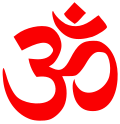 | Shingon (真言宗, Shingon-shū, "True Word / Mantra School") is one of the major schools of Buddhism in Japan and one of the few surviving Vajrayana lineages... 92 KB (11,519 words) - 05:47, 13 May 2024 |
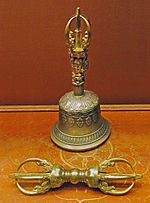 | Vajrayana (redirect from Tantric Buddhism) currently practiced, including Tibetan Buddhism, Chinese Esoteric Buddhism, Shingon Buddhism and Newar Buddhism. Historically, there were also other esoteric... 96 KB (11,558 words) - 09:48, 24 April 2024 |
 | Kūkai (category Shingon Buddhism) who founded the esoteric Shingon school of Buddhism. He travelled to China, where he studied Tangmi (Chinese Vajrayana Buddhism) under the monk Huiguo.... 34 KB (4,462 words) - 00:59, 27 April 2024 |
 | Mandala (section Shingon Buddhism) Mahayana Buddhism – Shingon Buddhism – makes frequent use of mandalas in its rituals as well, though the actual mandalas differ. When Shingon's founder... 47 KB (5,455 words) - 16:54, 25 April 2024 |
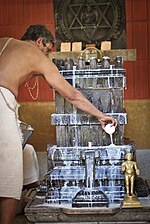 | Abhisheka (section Shingon Buddhism) empowerment ritual is present in Tibetan Buddhism as well as in Chinese Esoteric Buddhism and in Shingon Buddhism. The abhiṣeka was originally used as a... 9 KB (875 words) - 18:30, 21 February 2024 |
 | Land Buddhism with 22 million believers, followed by Nichiren Buddhism with 10 million believers, Shingon Buddhism with 5.4 million, Zen Buddhism with... 98 KB (11,797 words) - 19:50, 2 May 2024 |
 | of Former Heavens.[citation needed] Mārīcī, an important deity in the Shingon and Tendai schools, was adopted by the Samurai in the 8th century CE as... 19 KB (2,146 words) - 06:11, 29 March 2024 |
 | Sokushinbutsu (category Shingon Buddhism) practices of Shugendō were likely inspired by Kūkai, the founder of Shingon Buddhism, who ended his life by reducing and then stopping intake of food and... 11 KB (1,212 words) - 13:42, 6 March 2024 |
 | Vairocana (category Shingon Buddhism) Kegon, Shingon and esoteric lineages of Tendai. In the case of Huayan and Shingon, Vairocana is the central figure. In Chinese and Japanese Buddhism, Vairocana... 24 KB (2,468 words) - 05:30, 9 May 2024 |
 | Dharmapala (section Shingon Buddhism) venerated as dharmapālas as well. In Japanese Shingon Buddhism, a descendant of Tangmi, or Chinese Esoteric Buddhism, dharmapālas such as Acala and Yamantaka... 8 KB (790 words) - 15:23, 11 April 2024 |
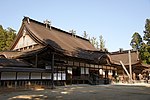 | Kongōbu-ji (金剛峯寺) is the ecclesiastic head temple of Kōyasan Shingon Buddhism, located on Mount Kōya (高野山, Kōya-san), Wakayama Prefecture, Japan. Its name... 5 KB (367 words) - 18:37, 2 October 2023 |
 | Mount Kōya (category Shingon Buddhism) sect of Shingon Buddhism. First settled in 819 by the monk Kūkai, Mount Kōya is primarily known as the world headquarters of the Kōyasan Shingon sect of... 14 KB (1,224 words) - 02:50, 6 February 2024 |
Samaya (category Shingon Buddhism) methods determined by their guru. In the esoteric lineage of Japanese Shingon Buddhism, the samaya precedes the Abhiseka initiation ceremony proper. The initiate... 8 KB (1,013 words) - 22:35, 22 March 2024 |
Sound symbolism (section Shingon Buddhism) concept of Sphota and Nirukta is also based on this. Kūkai, the founder of Shingon, wrote his Sound, word, reality in the 9th century which relates all sounds... 16 KB (1,967 words) - 15:53, 17 February 2024 |
 | Amitābha (redirect from Amida Buddhism) death. In Shingon Buddhism, Amitābha is seen as one of the thirteen Buddhas to whom practitioners can pay homage. Shingon, like Tibetan Buddhism, also uses... 26 KB (2,539 words) - 07:02, 28 March 2024 |
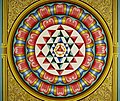 | Tantra (section Proto-Tantric elements in Buddhism) Indo-Tibetan Buddhism, Chinese Esoteric Buddhism, Japanese Shingon Buddhism and Nepalese Newar Buddhism. Although Southern Esoteric Buddhism does not directly... 120 KB (14,980 words) - 18:30, 10 May 2024 |
 | Heian period (section Developments in Buddhism) the ensuing centuries. Shingon is the Japanese version of the Zhenyen school from China, which is based on Vajrayana Buddhism. It was brought to Japan... 34 KB (4,587 words) - 03:16, 1 May 2024 |
Kuji-in (section Meanings in Buddhism) tradition of Japan and Ryōbu Shintō, which is the result of blending Shingon Buddhism and Shinto. The kuji are first introduced in the Bàopǔzǐ (Chinese:... 40 KB (6,233 words) - 16:29, 12 May 2024 |
 | Shikoku Pilgrimage (category Shingon Buddhism) Prefecture, which was settled by Kūkai and remains the headquarters of Shingon Buddhism. The 21 kilometres (13 mi) walking trail up to Kōya-san still exists... 37 KB (1,579 words) - 11:52, 27 April 2024 |
 | Homa (ritual) (category Shingon Buddhism) rituals are found in the Tendai and Shingon Buddhist traditions as well as in Shugendō and Shinto in Japan. In most Shingon temples, this ritual is performed... 25 KB (2,755 words) - 22:09, 26 April 2024 |
Buddhist liturgy (section Shingon Buddhism) is repeated twice more for a total of 9 recitations. The gongyo of Shingon Buddhism differs amongst various sub-sects, but all of them mainly recite the... 17 KB (2,257 words) - 21:34, 8 September 2023 |
Adhiṣṭhāna (category Shingon Buddhism) (gsol 'debs byin rlabs char 'bebs) (from the Yang Zab Nyingpo). In Shingon Buddhism, an extant non-Himalayan school of Vajrayana, practices involving mantras... 10 KB (1,146 words) - 19:09, 27 April 2024 |
Kōyasan Shingon-shū (高野山真言宗) is a Japanese sect of Shingon Buddhism. Headquartered on Mount Kōya in Wakayama Prefecture, it is also the oldest and largest... 505 bytes (42 words) - 16:54, 17 November 2023 |
 | Bhikkhu (redirect from Bonze (Buddhism)) discipline; after that, the sangha should not accept them again. In this way, Buddhism keeps the vows "clean". It is possible to keep them or to leave this lifestyle... 19 KB (1,976 words) - 20:31, 23 April 2024 |
 | Acala (category Shingon Buddhism) important and well-known divinities in Japanese Buddhism, being especially venerated in the Shingon, Tendai, Zen, and Nichiren sects, as well as in Shugendō... 64 KB (6,383 words) - 14:33, 27 February 2024 |



